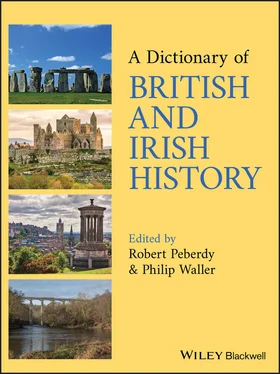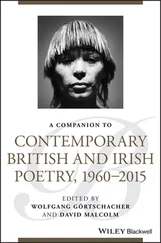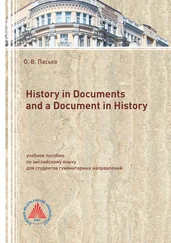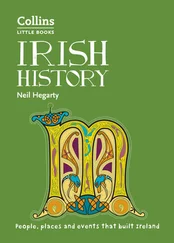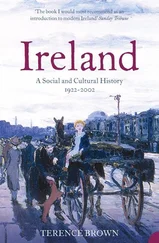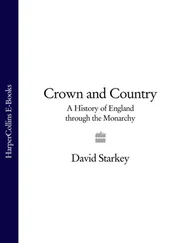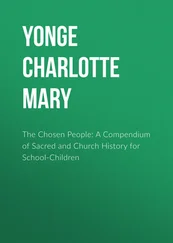The editors further hope that the book will prove useful to other groups who need to obtain basic historical information rapidly and easily, such as teachers, journalists, museum curators, tourism promoters, civil servants, diplomats and politicians — not to mention readers who have a natural curiosity about the past.
In providing a reference work on British and Irish history, the editors have sought to be even‐handed in dealing with the component parts of the British Isles. This is done in a flexible way. For some topics (e.g., housing, the Reformation) there are separate entries on the constituent parts of Britain and on Ireland. In other instances (e.g., divorce law), a single entry covers different jurisdictions.
The editors wish to draw attention to and explain certain features of the Dictionary .
Cross‐references: these occur within and at the end of entries and are shown by capitalization of words. Capitalized words within entries do not always correspond exactly to the headings of other entries; nevertheless they will be similar and easy to follow. Sometimes a key word within a phrase is capitalized to indicate an entry heading (e.g., ‘Church of Scotland’ refers to ‘Scotland, Church of’).
Personal names: people are generally referred to by their normally used names rather than full names (the latter are mentioned mostly to elucidate use of initials; e.g., ‘William Ewart Gladstone’ to explain the entry heading ‘Gladstone, W.E.’).
Historical periods: common period names (e.g., early medieval, Regency, Victorian) have been used sparingly; periods are frequently described in terms of centuries. This has been done partly to assist users who are unfamiliar with period names and partly because some names are used differently in the various parts of the British Isles. Period names are discussed in the entry ‘historical periods’.
Dates between 5 Oct. 1582 and 2 Sept. 1752: these are given as ‘Old Style’ dates as were used officially in Britain and Ireland (rather than as the ‘New Style’ dates that were used in Continental Europe following adoption of the Gregorian Calendar).
Start of year: this is taken throughout as 1 January, as became official in Scotland after 31 Dec. 1599 and in England, Wales and Ireland after 31 Dec. 1751.
References to shires/counties and kingdoms: where a place is located by reference to a shire or county (from the 10th century in England, later elsewhere), the unit is normally the contemporaneous one (e.g., before 1965 some places now within London, such as Chiswick, are located by reference to the former county of Middlesex). Places are also sometimes located by reference to a contemporaneous kingdom (e.g., Gwynedd, Mercia).
Places of birth and death in biographies: these are usually located partly by reference to the relevant contemporaneous kingdom, country or other territory, except that after the formation of Great Britain in 1707 places within Britain continue to be specified in relation to England, Scotland or Wales. In Ireland following partition (1921), places are located by reference to southern or Northern Ireland.
Numbering of rulers: because of the varying geographical extents of rulers’ authority within the British Isles, some rulers of ‘multiple kingdoms’ or unified kingdoms have conventionally been known by different numbers in each kingdom or by a particular numbering. The Dictionary uses the following conventions. James VI of Scotland is normally called ‘James VI/I’ after his accession as James I in England and Ireland (1603), and his later namesake is ‘James VII/II’. English numbering is used for rulers called Henry (Henry II to Henry VIII) as lords of Ireland; William III as king of Ireland (its first William) and Scotland (the second William); the following as rulers of the United Kingdom: William IV, Edward VII and Edward VIII (the first and second Edwards for Scotland) and Elizabeth II (Scotland’s first Elizabeth).
Use of term ‘lord’: references to the creation of a man as a ‘lord’ (from 1387 in England, 1462 in Ireland), or inheritance of such status, normally refer to the peerage rank of ‘baron’; other ranks, such as viscount, are usually designated. Note, however, that some men who ranked higher than baron are commonly referred to as ‘Lord’ (e.g., the 3rd Viscount Palmerston is usually called ‘Lord Palmerston’).
BRITISH AND IRISH PREHISTORYJohn Collis, Emeritus Professor of Archaeology, University of Sheffield
ROMAN BRITAINMartin Millett, FBA, Laurence Professor of Classical Archaeology, University of Cambridge
WALES, 5TH—15TH CENTURIEST.M. Charles‐Edwards, FBA, Emeritus Jesus Professor of Celtic, University of Oxford
WALES, 16TH—21ST CENTURIESAled Gruffydd Jones, formerly Sir John Williams Professor of Welsh History, Aberystwyth University, and National Librarian of Wales
NORTHERN BRITAIN & SCOTLAND, 5TH—15TH CENTURIESAlexander Grant, Reader in Medieval History, University of Lancaster
SCOTLAND, 16TH—21ST CENTURIESKeith Brown, Professor of History, and Vice‐President and Dean of the Faculty of Humanities, University of Manchester
IRELAND, 5TH—15TH CENTURIESSeán Duffy, Associate Professor of Medieval History, Trinity College, Dublin
IRELAND, 16TH—21ST CENTURIESR.F. Foster, FBA, Emeritus Professor of Irish History, University of Oxford ; Professor of Irish History and Literature, Queen Mary University of London
SOUTHERN BRITAIN & ENGLAND, 5TH—11TH CENTURIESPauline Stafford, Emeritus Professor of Early Medieval History, University of Liverpool
ENGLAND, 11TH—12TH CENTURIESJohn Hudson, FBA, Bishop Wardlaw Professor of Legal History, University of St Andrews
ENGLAND, 13TH—15TH CENTURIESJames G. Clark, Professor of History, University of Exeter
ENGLAND, 16TH CENTURYAndrew Pettegree, Professor of Modern History, University of St Andrews
ENGLAND, 17TH CENTURYClive Holmes, Emeritus Fellow, Lady Margaret Hall, Oxford
ENGLAND & GREAT BRITAIN, 18TH CENTURYSir David Eastwood, Vice‐Chancellor, University of Birmingham
ENGLAND & GREAT BRITAIN, 19TH CENTURYJanet Howarth, Emeritus Fellow, St Hilda’s College, Oxford
ENGLAND & GREAT BRITAIN, 20TH—21ST CENTURIESJ.S. Rowett, Emeritus Fellow, Brasenose College, Oxford
IMPERIAL HISTORYT.N. Harper, Professor of the History of Southeast Asia, University of Cambridge ; Fellow of Magdalene College, Cambridge
ADVISER FOR SCHOOLSAndrew White, formerly history teacher, Cherwell School, Oxford, and tutor at the Oxford University Department of Education
CARTOGRAPHERGiles Darkes, Oxford
David Ashton, Deputy Principal, Royal Holloway, University of London
Brian Blacker, independent scholar
James S. Bothwell, Lecturer in Later Medieval History, University of Leicester
Richard Brickstock, formerly Lecturer and Researcher in Archaeology and Ancient History at the Universities of Durham and Leeds
James G. Clark, Professor of History, University of Exeter
Simon Coates†, sometime British Academy Postdoctoral Research Fellow, King’s College London
Читать дальше
